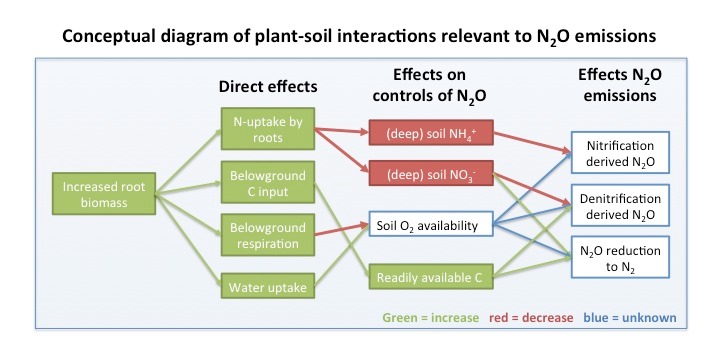Rooting for a sustainable future: Can Crops with Greater Rooting Systems Improve Nitrogen Retention and Mitigate Emissions of Nitrous Oxide?
Background and Objectives
- Nitrogen (N) fertilization is essential for productivity in modern cropping systems. However, excess N inputs lead to NO3- leaching, which causes pollution of ground- and surface waters, as well as emissions of N2O, a potent greenhouse gas.
- Breeding and cultivation of crops with deep and extensive rooting systems has been proposed as a strategy to improve N sequestration in agricultural ecosystems
- However, little is known about the effect of rooting depth on N-cycling and N2O emissions
- In the ‘roots and N2O project’, the effect of plant rooting depth on N-cycling and sources of N2O production within the plant-soil system and throughout the soil profile will be assessed.
Hypotheses
Greater root depth and root biomass will
- increase N use efficiency and decrease N losses in the form of N leaching and N2O emissions;
- increase N retention by shifting the fate of NH4+ from more nitrification toward more immobilization; and
- increase the depth of maximum N2O production and decrease the ratio of N2O:(N2O+N2) in denitrification end-products.
Experimental Approach
N2O emissions are often difficult to predict because they are very variable in space and time. In addition, they can be caused by various soil processes, each of which are favored under different soil conditions. Recent developments in measurements of N2O isotopes, especially the intramolecular distribution of 15N in N2O (also known as site preference or SP), have proven to be promising to identify different sources of N2O.
For this project, 4 genotypes of wheat with differing root production will be grown in tall columns in the greenhouse. N-cycling and N2O emissions throughout the depth profile will be assessed. Therefore, NH4+, NO3-, and N2O concentrations and isotope values (δ15N, δ18O, SP) will be measured at 7.5, 30, 60, 90 and 120 cm depth, and sources of N2O will be constraint based on N2O isotopes. In addition, soil subsamples will be collected to determine potential gross N transformation rates and N2O reduction potential using 15N tracers and isotope pool dilution, during tillering, stem extension and flowering.
For further information please contact Johan Six ().

